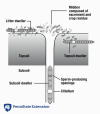|
Earthworms dramatically alter soil structure, water
movement, nutrient dynamics, and plant growth. They
are not essential to all healthy soil systems, but
their presence is usually an indicator of a healthy
system. Earthworms perform several beneficial
functions.
Stimulate microbial activity.
Although
earthworms derive their nutrition from
microorganisms, many more microorganisms are present
in their feces or casts than in the organic matter
that they consume. As organic matter passes through
their intestines, it is fragmented and inoculated
with microorganisms. Increased microbial activity
facilitates the cycling of nutrients from organic
matter and their conversion into forms readily taken
up by plants.
Mix and aggregate soil.
As they consume
organic matter and mineral particles, earthworms
excrete wastes in the form of casts, a type of soil
aggregate. It has been calculated that earthworms
can move large amounts of soil from the lower strata
to the surface and also carry organic matter down
into deeper soil layers. A large proportion of soil
passes through the guts of earthworms, and they can
turn over the top six inches of soil in ten
to twenty years.
Increase infiltration.
Earthworms enhance
porosity as they move through the soil. Some species
make permanent burrows deep into the soil. These
burrows can persist long after the inhabitant has
died, and can be a major conduit for soil drainage,
particularly under heavy rainfall. At the same time,
the burrows minimize surface water erosion. The
horizontal burrowing of other species in the top
several inches of soil increases overall porosity
and drainage.
Improve water-holding capacity.
By
fragmenting organic matter, and increasing soil
porosity and aggregation, earthworms can
significantly increase the water-holding capacity of
soils.
Provide channels for root growth.
The
channels made by deep-burrowing earthworms are lined
with readily available nutrients and make it easier
for roots to penetrate deep into the soil.
Bury and shred plant residue.
Plant and
crop residue are gradually buried by cast material
deposited on the surface and as earthworms pull
surface residue into their burrows. |


